Menus
- Sports tourers in the comparison test
- The wheelbase of the R 1250 RS is significantly longer
- Kawa lighter in comparison
- Z 1000 SX with sporty genes
- Both delay without blame or blame
- Conclusion
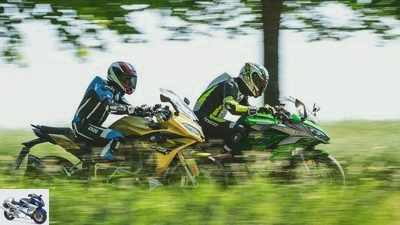
Tyson Jopson
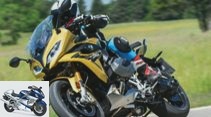
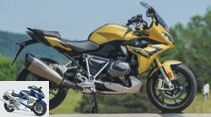
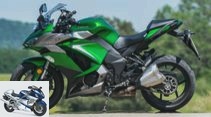

16 photos
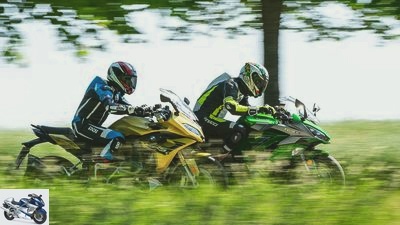
Tyson Jopson
1/16
Who makes the race in the comparison of the BMW R 1250 RS against the Kawasaki Z 1000 SX?
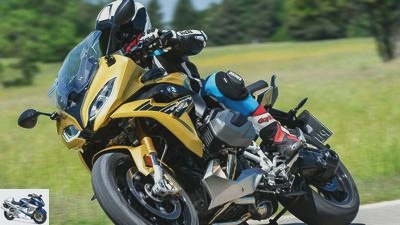
Tyson Jopson
2/16
Sheer driving pleasure: In view of the dimensions, the RS is astonishingly neutral and easy to handle.
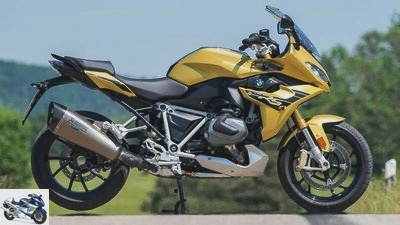
Tyson Jopson
3/16
Quite a long motorcycle with a lot of space. The standard bench is positioned rather low.

Tyson Jopson
4/16
The Z is more compact. Its inline four-cylinder drives the rear wheel via a chain.
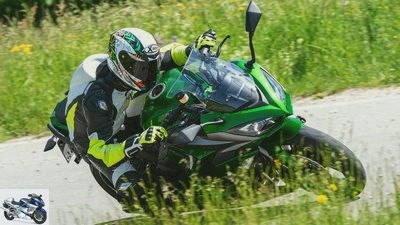
Tyson Jopson
5/16
Instead of neutrality, the Kawasaki offers curve greed, wants to fold further on its own. You get used to it.
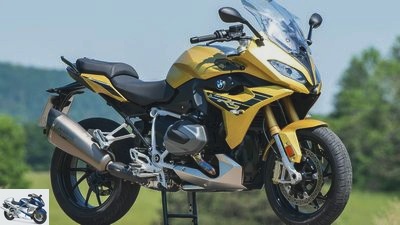
Tyson Jopson
6/16
Overall not exactly narrow, but extremely pleasant in terms of ergonomics. The length benefits the driver and passenger.
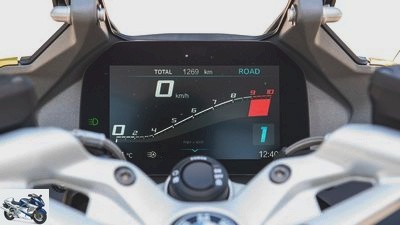
Tyson Jopson
7/16
State of the art: This TFT adorns all new high-priced BMWs. Readability, range of information and operation are excellent.
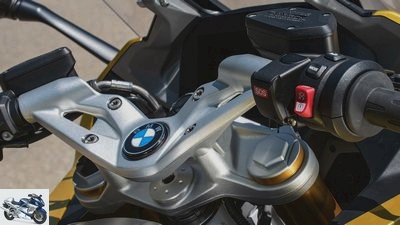
Tyson Jopson
8/16
The boom mounted on the upper triple clamp attracts attention and conveys quality. Otherwise perfect processing.

Tyson Jopson
9/16
The Kawasaki has a particularly slim crotch / knee. It offers a lot of space for the driver, but not for the pillion passenger.
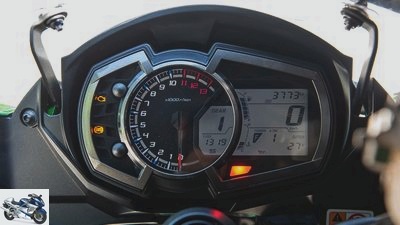
Tyson Jopson
10/16
Shows only slightly less, and that with good contrast, only a bit small in places. But it looks less modern.
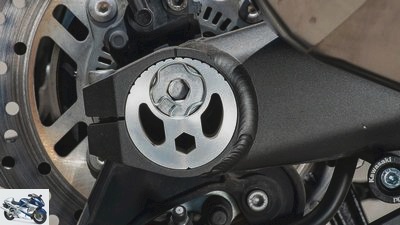
Tyson Jopson
11/16
The Kawasaki is well made, but particularly pretty details such as the eccentric for tensioning the chain are few and far between.

Tyson Jopson
12/16
Both are handy in their own way, conveying good driving pleasure with adequate comfort at the same time. The RS is also stable and neutral. We really liked the fork of the Kawasaki.
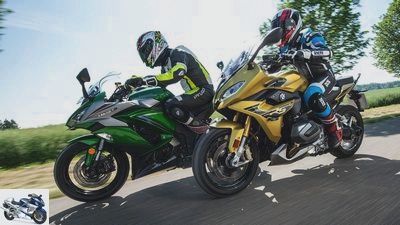
Tyson Jopson
13/16
The pulling power, characteristics and especially the fine responsiveness of the current boxer are splendid, it fits perfectly into a sports tourer. Short gear ratio and also considerable top-end power give the Kawa fiery acceleration.
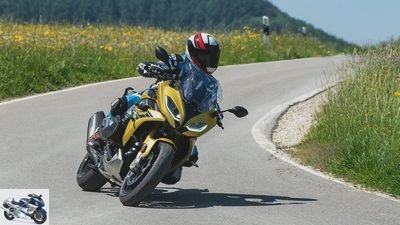
Tyson Jopson
14/16
The BMW achieved 737 points out of 1000 in the overall standings. The Kawasaki achieved 709 points and thus took 2nd place.

Tyson Jopson
15/16
In the end, the BMW won the test with 737 out of a possible 1000 points. The Kawasaki lands at 709 points.
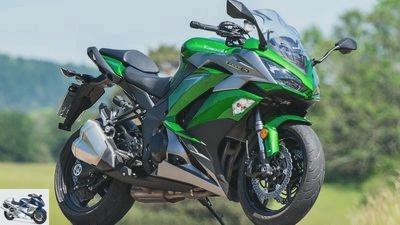
Tyson Jopson
16/16
Winner price-performance ratio: Z 1000 SX For just under 13 Mille you get a great sports tourer, for just a little more you can even get a good suitcase.
BMW R 1250 RS versus Kawasaki Z 1000 SX
Sports tourers in the comparison test
Two strong sports tourers in the test. BMW R 1250 RS and Kawasaki Z 1000 SX are perfectly equipped for the balancing act between traveling and racing and are still the first choice for two or a sporty short trip.
When and why did sports tourers go out of style? Is it really better to ride the egg-laying woolly milk pig travel enduro? Or can she do everything just a little and nothing really well? Does a kawa always have to be green? And why does the tubular frame of this BMW remind us of a hospital bed? More or less ingenious, subtle things could be cited at this meeting of the new R 1250 RS and the new R 1250 RS, which are upgraded in a familiar manner with the Shift Cam Boxer Kawasaki Z 1000 SX, which has been proving its merits since the 2017 season. But there is a lot to report, so to the point.
Buy complete article
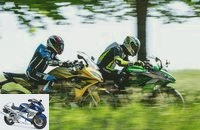
Comparison between BMW R 1250 RS and Kawasaki Z 1000 SX
2 for everything
Meet at eye level
Formally, this is a meeting at eye level: 17-inch wheelsets and moderate suspension travel here and there, handlebar stubs mounted on elevations above the fork bridge and sleek front-wheel-oriented, but usable wind protection that promises – and offers – covers both are crystal clear. They are sports tourers. In addition, the nominal 136 hp of the two-cylinder boxer meet 142 hp of the four-cylinder Kawa, on the test stand things are even closer. In terms of price, the rivals are also in the same league, based on the basic equipment: Kawasaki starts at 13,000 euros, and BMW calls for 14,400 euros for an R 1250 RS without extras. The lush but not fully equipped test machine is as far away from the base price as the moon from Munich.
Tyson Jopson
Both are handy in their own way, conveying good driving pleasure with adequate comfort at the same time.
In general, the similarities end with the formal. In the broad spectrum between sport and touring, both of them with different characters fit into different points. The reasons for this lie in their origin. The Kawasaki comes from a sporty Power Naked, the Z 1000. The wheelbase and caster are correspondingly short, the steering head angle is rather steep, the final drive is via a chain that requires more maintenance. With a full 19-liter tank, the weight levels off at a moderate 236 kilograms. Good systems for agile handling. But the Greens have successfully taught the Z 1000 to tour, the space is fully sufficient despite its relative compactness: You sit slightly front-facing, with wide elbows (the cranking of the stub is special, but works); The tank, which is narrow at the crotch, is particularly pleasing, there is enough space to the rear for taller people. Only in row two is it a little – but really only a little – more cramped.
The wheelbase of the R 1250 RS is significantly longer
The R 1250 RS is also based on or was developed in parallel with the undisguised, but compared to the Z 1000 much more dignified platform sister, the R 1250 R. Its wheelbase is significantly longer – a full 70 millimeters separate the two – the key data are more conservative, with It weighs noticeably more 254 kilograms with a full 18 liter tank. You feel this difference less when driving, more when maneuvering, but above all when sitting up. Like all Boxer BMWs, the R 1250 RS is a fully grown motorcycle that requires a firm hand. The stubs are at a comfortable height, considering the size of the machine, the standard bench is quite low, and its incredibly good upholstery provides an enormous feel-good factor. The tank is longer and wider, the R 1250 RS is designed for people from 1.80 meters up. In row two, in particular, the lush dimensions are also noticeable in the form of more generous space.
Tyson Jopson
In view of the dimensions, the RS is surprisingly neutral and easy to handle.
Come on! The Z 1000 SX sounds dry, hissy, but pleasantly muffled. Four-cylinder, igniting in conventional sequence. In contrast, the metallic barking of the boxer is far more dominant. The polished, more subtle acoustic appearance of the Z 1000 SX is continued in an extremely smooth-running, very accurately metered clutch. There is no such thing as a quickshifter or a blipper that is gradually becoming a good standard in this price league. But we didn’t miss it too much, because the gearbox sorts its gears very playfully with the least effort and on the shortest possible routes. The smooth running smoothness of the in-line four-cylinder engine in the first half of the speed is also convincing, only in the last third of the speed, which is less frequently visited, the handlebars and footrests tingle and electrify. Let’s book it as a character.
Kawa lighter in comparison
A large-volume two-cylinder – after all, every combustion chamber of the R 1250 R measures 627 cubic centimeters – can never offer this sophistication? That’s not true. It is true that the twin can always be identified as such in the case of excessively low-speed driving with a high load. But even here the amount of vibration remains surprisingly low. Even on this side of 2,000 revs, the boxer finds, thanks to the well-known variable valve control, an almost eerie smoothness that is not only unparalleled among the two-cylinder, but is in no way inferior to the four-cylinder. Silky.
Tyson Jopson
Instead of neutrality, the Kawasaki offers curve greed, wants to fold further on its own.
And full of lard, because the advantages of the large individual cubic capacities remain, supplemented by the technical advantages of variable valve control. To repeat in simple terms what we have already found during the tests of the GS and R 1250 R: This engine cracks badly when necessary. It compensates for its significantly longer overall gear ratio and the lower weight of the Kawa, and offers very confident, relaxed pulls. Above all, however, it works extremely precisely through all driving modes, reacts spontaneously but precisely to gas commands. That fits perfectly with a sports tourer.
Z 1000 SX with sporty genes
When it comes to the acceleration measurement, however, the Z 1000 SX is just ahead of the curve despite its displacement disadvantage. On the flip side of the coin, its speed level at cruising speed is quite high, whereas the BMW turns nice and low even at recommended speed. Incidentally, the R 1250 RS also offers a smooth-running clutch (hydraulically operated), but its transmission has longer shift travel and more audible gear shifts in the lower, wider gears. A good quickshifter / blipper was installed on the test motorcycle as part of the usual package phalanx. As always, it has its price, and it’s a whopping 18,030 euros. Without a suitcase, mind you. The Kawasaki, which was delivered as a “tourer” with a GPS holder, tank pad and good suitcases, would cost 13,895 euros if equipped.
Tyson Jopson
The RS is stable and neutral. The Kawasaki fork was very good in the test.
If you lead the Z 1000 SX through a series of tight alternating curves, the sporty genes come into their own. It swings with little effort and is actually very agile, provides good feedback, and offers an overall very active, motivated driving behavior for a motorcycle that is fully suitable for touring. If only it weren’t for the self-steering behavior: The SX requires permanent pressure on the handlebars in long radii, wants to be prevented from folding down further, and also stands up noticeably on the brake. A well-known finding, to blame is the Bridgestone S 20 “N”, which is designed for safe straight-line stability. Sponge over it, because you get used to it.
Both delay without blame or blame
The R 1250 RS curves nicely with less obstinacy. Despite its conservative geometry and weight of a good five hundred pounds, its handling is characterized by an almost dance-like ease. Above all, it remains absolutely neutral over the entire lean angle, conveying a harmonious driving experience. Also shows hardly any set-up moment and also has a great all-weather tire with the Pilot Road 4. However, the BMW does not seem as grounded as with the Kawa, the feedback is far less sensitive. When it comes to the quality of the chassis, the two are no different. For example, the semi-active chassis of the RS, which is subject to a surcharge, offers advantages in terms of ease of use and the automatic level control of the shock absorber to adjust the load. But the handwheel of the Z 1000 SX also makes this very easy. We particularly liked the responsiveness of their USD fork. If you disregard the steering behavior, the chassis of the Z 1000 SX cannot be blamed in the slightest.
Tyson Jopson
In the end, the BMW won the test with 737 out of a possible 1000 points. The Kawasaki lands at 709 points.
A similar finding – Kawasaki perfect, BMW that crucial bit better – then also with the brakes and electronics. Both delay without any flaws or blame – whether you prefer the heavy initial bite of the RS or the gentle grip of the SX is a matter of taste. With the Kawa, too, the ABS controls extremely sensitively and supported by lean angle sensors. In terms of driving modes, however, with the cockpit, with its range of functions and the entire operating concept, the BMW is clearly the more modern motorcycle that offers a lot more “features”. Is that worth an additional 5,000 euros? The R 1250 RS wins the comparison. The Z 1000 SX offers a better price-performance ratio.
Conclusion
The size of the BMW alone brings it closer to the Tour in the Sport Tour spectrum. But: thanks to the even more powerful engine, thanks to the perfectly neutral, light-footed handling, thanks to expensive equipment orgy and the finest electronics, the R 1250 RS is also a lot of driving pleasure. A mega sports tourer. In contrast to the expensive BMW, the Kawasaki Z 1000 SX is a sporty – also simpler – motorcycle at its heart that has learned to tour. And so find a nice, more active compromise. The engine, chassis and brakes work perfectly, the price-performance ratio is right. Only the initial tires spoil the idea for a long time.
Related articles
-
Comparison test Honda VFR 800 F, Kawasaki Z 1000 SX and BMW R 1200 RS
fact 32 pictures fact 1/32 The Honda VFR 800 F looks small and compact, but carries a lot of weight with it: 245 kg with a full tank. fact 2/32 The …
-
BMW R 1200 R, Triumph Speed Triple and Honda CB 1000 R in comparison test
Bilski 48 photos Bilski 1/48 Triumph Speed Triple. Bilski 2/48 Curve artist. As is typical for Honda, the Honda CB 1000 R also makes it easy for its…
-
Comparison test sports tourer Kawasaki Z 1000 SX Tourer, Triumph Sprint GT
www. 35 pictures www. 1/35 Sports tourers sit between all chairs, but the temptation lies in this niche: there are bikes, …
-
fact Concept comparison Honda CBR 1100 XX Kawasaki ZX-12 R Suzuki GSX-R 1000 Suzuki GSX 1400 Yamaha FZS 1000 Fazer Yamaha FJR 1300 Six bombs The six …
-
BMW F 800 GT, Kawasaki Z 1000 SX and Honda VFR 800 F in the test
fact 44 photos fact 1/44 fact 2/44 fact 3/44 fact 4/44 fact 5/44 In praise of diversity: the three test candidates all want the same thing, but try to…
-
factstudio.de 29 photos fact 1/29 One against all. Ducati SuperSport S in comparison test with Suzuki GSX-S 1000 F, Kawasaki Z 1000 SX, Honda VFR 800 F…
-
Comparison test BMW S 1000 RR, Kawasaki ZX-10R and Yamaha YZF-R1M
22 images 1/22 BMW S 1000 RR, Kawasaki Ninja ZX-10R and Yamaha YZF-R1M. 2/22 Yamaha YZF-R1M. 3/22 BMW …
-
Ducati Multistrada 1200, Kawasaki Versys 1000 and Triumph Tiger 1050 in the test
Gargolov Funbikes in comparison test Ducati Multistrada 1200, Kawasaki Versys 1000 and Triumph Tiger 1050 With bag and pack on a big tour or simply …
-
Comparison test of the 1000 super sports car, part 2
Jahn comparison test 1000 super sports car, part 2 The street sweepers Fun country road surfing, everyday operation, sober cost-benefit calculation ?? in the…
-
BMW S 1000 XR, Kawasaki ZZR 1400 and KTM 1290 Super Duke GT in the test
Andreas Riedmann 25 pictures andreasriedmann.at 1/25 picture gallery comparison test, power-speed touring bikes: BMW S 1000 XR, Kawasaki ZZR 1400, KTM 1290 …